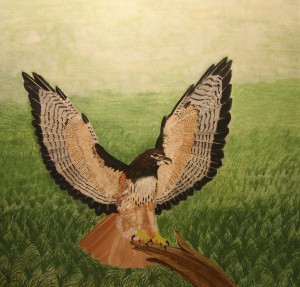Scientific Name: Buteo jamaicensis Wingspan/Size: 48”/18”
How to identify them:
In the adult, the upper parts are dark grey-brown, streaked and barred with lighter colors. The tail is red above and lighter dull brick below. Underparts are light cream, streaked with brown. Imatures look like adults but their tails are finely streaked on the upper side. They will not obtain their adult plumage until their second year.
Where to find them in Oregon:
Most common hawk of Oregon. Seen through out the state. Often seen along I-5 sitting in trees or on fence posts.
Preferred Habitat:
Grasslands bordered by trees or cliffs for roosting.
General Behavior:
They feed mainly on mice and other small rodents and birds. They will return over and over to the same areas and have predictable flight areas and hunting locations.
Nesting Behavior:
The two to four white eggs are marked with brown speckles and are found in a nest of sticks in a tree or on cliffs. They have a thirty day incubation and fledge at approximately six weeks. The parents care for and train their youngs.
Citations:
Udvardy, Miklos D.F.,The Audubon Society Field Guide to North American Birds, Sacramento, Slfred A. Knopf, Inc 1977 p 538
Gabrielson, Ira N., Jewett, Stanley G., Birds of the Pacific Northwest, New York, Dover Publications, 1970 (originally published by Oregon State College as Birds of Oregon in 1940. (Republished by Dover Publications by special arrangement with Oregon State University) p 187
Peterson, Roger Tory, A Field Guide to Western Birds, Boston: Houghton Mifflin Company, 1961 pp 64-65
Order: Falconiformew
Genus: jamaicensis
This is probably the most often seen of all the buteo of Oregon. They will perch in one location for extended periods and use the same perch over and over. Their activity patterns are consistent day after day. They will leave their rooting area for a warm up flight to check out their four square mile range. The hunting area generally consists of two major locations that are rotated morning and afternoon.
Most flights during the day are ¼ mile each.
Paired hawks hunt together and will stay in the same areas often exchanging perches or sharing a rooting area. They do not often share a kill. They will defend their range against other red tailed hawks, eagles, owls and other raptors. Hunting is the major activity and lasts till dusk. Strikes are far more unsuccessful than successful.
They lay two to four white eggs marked with brown speckles in a stick nest on cliffs or in trees. The eggs are incubated for thirty days. Young fledge at approximately six weeks, then go through a period of parental care and training.
Their prey consists mainly of rodents, squirrels, small mammals and birds. They prefer high perches of thirty to fifty feet high, but will use what’s available.
Red tailed hawks can be found from Panama to northern Canada. They are both powerful and aggressive. Their distinctive red tail is a sign of maturity. Females are usually larger than the male.
Hawks have much sharper vision than man. Their eyes have more light-sensitive cells and most have more than one fovea (an area of the retina) They can see a rabbit distinctly from a great distance.
Hawks have had both a love and hate heritage with man. Falconry was the sport of kings. Birds of prey were raised in captivity and trained to hunt on command. The birds were hooded, leashed to the handlers heavily gloved-gauntleted hand. A great deal of affection and pride were associated with these magnificent hunters.

